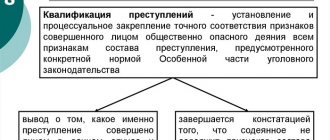Covered by the disposition of Art. 209 of the Criminal Code and acts provided for in Art. 35 of the Criminal Code (creation of an organized group, management of it). In accordance with the explanations available in the Resolution of the Plenum of the Supreme Court of the Russian Federation dated January 17, 1997, the commission of other crimes during banditry requires their additional qualification under the relevant articles of the Criminal Code. This rule will eliminate from practice different approaches to classifying crimes committed by a gangster group.
As you know, criminal law is one of the most important means of fighting crime. The application of criminal law leads to the selection and imposition of punishment. And the next step is the execution of the assigned punishment. Analysis of law enforcement practice shows that criminal law measures do not sufficiently provide reliable protection of objects of criminal law protection from gang attacks. The principle of the inevitability of punishment is not sufficiently effective, and, as correctly noted in the literature, violation of this principle and inconsistency in its implementation significantly reduces the authority and power of the criminal law, its preventive potential and correctional and educational influence, which negatively affects the entire system of combating crime.”21
Criminal practice in terms of sentencing for banditry should currently serve the purpose of strengthening the preventive impact on persons prone to committing this crime. Disapproval by society and the state of the ever-increasing cases of banditry should be expressed in the imposition of more severe punishments for them and in the non-application of mitigating measures to bandits, as well as reducing the term of serving the sentence and other similar measures.
Based on the issues I studied in this chapter, I came to the conclusion that the 1996 Criminal Code of the Russian Federation has many omissions and shortcomings in connection with which difficulties arise in qualifying banditry and distinguishing it from other similar crimes. The legislator does not provide clear criteria for distinguishing banditry from a criminal community, robbery, or illegal armed group. But on this account there are many scientific articles and other works of legal scholars, and many of them directly fought against banditry. I think that legislative bodies should pay more attention to the opinions of these scientists when introducing further changes to the Criminal Code.
crimes
The main requirements for the effectiveness of the criminal legal fight against banditry are its correct qualification and differentiation from similar violent groups. At the same time, the correct qualification of banditry makes it possible to apply adequate penalties to the perpetrators and thus increase the preventive role of the criminal law.
Unfortunately, in practice, even to this day, there are significant errors in the classification of banditry, as a result of which criminals receive punishment that does not correspond to the act they committed. I see one of the reasons for these errors in forensic investigative practice in the fact that the often poor preparation of the evidence base by operational workers when developing gangster groups, the inability on the part of investigators to establish all the necessary signs of gangsterism when combining serial armed group crimes into one proceeding do not allow law enforcement agencies to complete Many criminal cases of banditry are taken to their logical conclusion.
To avoid such mistakes, law enforcement officials need to be able to correctly distinguish banditry from related crimes. First of all, banditry has similar features to robbery committed by a group of persons by prior conspiracy with the use of weapons. The presence of such signs as the use of violence, seizure of property for mercenary purposes, the group nature of actions, and often the use of weapons, causes certain difficulties in distinguishing between these crimes.
In practice, the problem of distinguishing between robbery and banditry is often encountered. Robbery is committed for the sole mercenary purpose - to seize property, while the goals of a gang attack are not limited to this and can be aimed at committing murders, rapes, taking possession of weapons, or the uniform and documents of police officers, theft of vehicles and other crimes.
R. Galiakbarov offers the following criteria for distinguishing banditry from robbery:
- firstly, in a robbery committed by an organized group of persons, the presence of weapons or objects used as weapons is established. A gang should only have weapons;
- secondly, in robbery, weapons must be used for their intended purpose. Banditry requires only the presence of weapons;
— thirdly, there is a difference in the moment of the end of the encroachments. According to clause “d”, part 2 of Art. 162 of the Criminal Code, robbery is qualified in cases where a weapon was used during the attack. An attack by an armed gang is considered to have taken place even when the weapons owned by the gang members were not used (clause 6 of the mentioned resolution). Moreover, the very creation of a gang constitutes a complete crime.22
Indeed, if the use of weapons is a mandatory sign of qualified robbery, then to recognize the crime as banditry, it does not matter whether it was used by gang members during attacks or not. A robbery attack is always accompanied by violence or the threat of violence that is dangerous to the life or health of the person attacked. In banditry, the actual use of any violence or threat of violence is not necessary if the criminal result is achieved without its use.
Objects that are not actually weapons can also be used as weapons during robbery. For banditry, it is necessary to have only weapons in the proper sense of this concept, that is, objects specifically designed to defeat a living target. Robbery necessarily involves an attack with the aim of seizing property; banditry, in addition to selfish goals, can also pursue other goals.
To illustrate the above points, consider the following example. The Khasavyurt City Court convicted a group of Sh., consisting of five people, who committed 6 robberies on highways. An analysis of this criminal case shows that the group was armed, united and specially organized for the purpose of attacks on vehicles in order to seize property. The repeated occurrence of attacks and the stability of this group indicate that this is not a robbery group, but a gang.23
Banditry has certain similarities with skilled extortion.
Analysis of the norm providing for liability for banditry and the norms of the criminal code, which describe various types of violence in the commission of crimes, allows us to classify the threat of murder or the use of violence dangerous to life and health as attacks characteristic of a gangster formation; violence dangerous to life and health; causing grievous bodily harm; premeditated murder with aggravating and without aggravating circumstances.
Banditry has a number of similarities with terrorism, the organization of an illegal armed group or participation in it, and the organization of a criminal community (criminal organization).
As with banditry, an illegal armed group is characterized by a group nature, armament, organization of a group or participation in it. However, an illegal armed formation is not a bandit group, but an association, detachment, squad or other organized armed group.
The concept and signs of banditry
Banditry is one of the most dangerous crimes in the theory of criminal law.
Criminal legislation also distinguishes the special composition of banditry, but in the legislation of other countries this concept is adjacent to such crimes as robbery, extortion, and other violent crimes. Note 1
The criminal legislation of the CIS considers banditry as a stable armed group of people who are closely related to each other by the goals of their criminal activities; this group has such characteristics as organization, stability, attacks on government organizations, public institutions, enterprises, and citizens.
Signs of banditry are as follows:
Are you an expert in this subject area? We invite you to become the author of the Directory Working Conditions
- Participation of two or more persons, each of whom has the characteristics of a subject of a crime (sanity, reaching the age of criminal responsibility). Legal entities cannot be considered gang members.
- Armament and awareness of gang members about the goals of its activities. All participants must know what the gang is doing.
- Gang members must be united and organized.
The gang must have signs of being armed, and the weapons can be either legal or prohibited (for example, a license is required for some types of weapons). It is also possible to use objects that are adapted for attacking and hitting people, for example, brass knuckles, a stick, a baton. Persons who both organized a gang and joined it are subject to criminal liability. Persons over 16 years of age may be held criminally liable.
In the 90s of the 20th century, many similar gangs operated. Thus, the Volgovskaya organized crime group, created by residents of the city of Togliatti, who were employees of the local Volga hotel, was quite powerful. Their criminal activity consisted of stealing and selling parts from. Gradually the group grew, as did its income. Gang members earned over 400 million dollars a year. Subsequently, the gang members were detained, and its leader was shot by his competitors. The last head of the so-called “Volgovskys,” Viktor Pchelin, was caught in 2007, and until that moment he had been on the run for 10 years.
Finished works on a similar topic
Course work Criminal-legal characteristics of banditry 410 ₽ Abstract Criminal-legal characteristics of banditry 220 ₽ Test work Criminal-legal characteristics of banditry 220 ₽
Receive completed work or specialist advice on your educational project Find out the cost
One of the most dangerous gangs is the Yakuza. This group was founded in the 17th century. Currently, according to rough estimates, there are about 100 thousand members of this group. In 2014, according to Forbes estimates, the income of this group amounted to about 6.6 billion dollars.
Composition of banditry
The objective side of bandit activity involves 4 options, these are:
- creation of a criminal group;
- gang leadership;
- direct participation in gang warfare;
- participation in gang attacks.
For the first two points, liability is provided for in Part 1 under Art. 209, the last two options face punishment, according to Part 2, Art. 209.
Signs of a gangster group are:
- the presence of 2 or more sane adults who have reached the age of criminal responsibility;
- the goal is an attack on organizations or citizens.
- armament;
- sustainability.
The creation of a gang is the formation of an organized armed group that has targeted actions in the form of attacks against citizens or organizations.
The creation of a group is considered a completed process from the moment of its formation, regardless of the commission of planned attacks.
Gang leadership is associated with the organization, planning of the criminal activities of the gang, its material support and the commission of attacks.
Armedness means the presence of any weapon in at least one person from the gang, provided that other members of the group know about this weapon.
The main feature of banditry, which distinguishes this type of crime, is sustainability.
In the explanations of the Plenum of the Supreme Court of the Russian Federation in 1997, the stability of a gang can be evidenced by:
- composition stability;
- the duration of the gang's existence;
- coordination of actions;
- close relationship between its members;
- consistency of methods of criminal activity;
- number of crimes committed.
If a person created a gang, manages it and leads it, then the subject will be charged with organizing and leading the group at the same time.
Let’s say the leader could “retire” and no longer take part in its further development, in which case he would only be responsible for the creation of the gang.
If he did not create a gangster group, but took over the leadership of an already formed community, then he will be responsible for leading the gang.
Participation in a gang is also a type of crime, for which punishment is provided in Part 2, Art. 209.
The perpetrator will be tried not only for participation in attacks, but also for performing other active actions, such as searching for targets for attack, financing, providing transport and weapons.
He will be held accountable for his actions not only when he participates in gang attacks. He may not even be a member of a gang, but only a participant in the attacks.
He will bear responsibility for banditry even when he helps with financial resources or other types of services.
Participation in a gangster group is considered a crime from the moment you give your consent.
Such consent can be given in any way - a sign system of information, an active expression of one’s delight, or other actions understandable to gang members.
By giving his consent to participate in a gang, he may not do anything at all, but he gives others confidence that they can count on him in a certain situation.
Therefore, the fact of agreeing to participate strengthens the resolve of other gang members who are aware of the potential support of this participant.
Aiding and complicity
Participation in attacks presupposes the subject's direct participation in the objectification of the bandits' plans and complicity . In court, this is considered co-perpetrator, indicating the role played by the subject in the attack.
To qualify the action, it is not at all necessary that this person be a member of a gang. They may turn out to be an acquaintance of a bandit who has accidentally met and who has given his consent to help in the robbery.
But at the same time, it is necessary that he knows exactly in which gang he agreed to commit the crime. Otherwise, due to ignorance of the gang’s actual participation in the attack, his actions will be classified as a crime actually committed, and as a group of persons.
If harm was caused as a result of the attack - property damage, bodily injury or death, then the gang members will be punished in conjunction with the atrocities they committed as part of the gang association.
The subjective side of banditry includes a special purpose and direct intent. The person is aware that he has created an armed group, leads it, participates in attacks organized by the gang, and also wants to commit these actions or all of them together.
The subject of banditry is considered to be a sane person over 16 years of age . If the attack involved minors who have reached the age of 14, then they can be prosecuted only for those actions for which they are tried from the age of 14, for example, for murder as part of a gang.
In Art. 209, Part 3 provides for increased liability for banditry by a subject who has used his official position.
This means that the person actively used his official powers in preparing attacks, providing the bandits with weapons, official identification, uniforms and paraphernalia, as well as information that the subject has in his official position.
Many citizens are interested in the composition of banditry and the types of this crime. When forming a gang, it is assumed that:
- the group will involve two or more people;
- violence is regarded as achieving a goal, even if this requires starting an arson or even killing someone;
- there is a leader who controls the gang members, proposes or approves crime schemes (the candidacy of the leader is approved by voting);
- participants have weapons (firearms, bladed weapons, sharpeners, brass knuckles) and others know about it;
- the group is created specifically to carry out attacks on an ongoing basis;
- the direction of their activities may violate other articles of the Criminal Code (extortion, robbery, robbery, murder);
- participants have reached the age of majority and can be responsible for their actions.
Banditry is considered a completed crime from the moment an armed group is formed, even if its members have not yet attacked anyone or taken personal property. The bandit organization itself poses a security threat to many people.
Group organization
In Part 1 of Art. 209 of the Criminal Code of the Russian Federation describes the responsibility that the creator and leader of the gang bear. It states that the creation and leadership of an armed group for the purpose of attack is punishable by imprisonment for a term of 10 to 15 years and a fine of up to 1 million rubles.
To incriminate a gang leader for his creation, it is necessary that the subject:
- found potential members of the group and entered into a conspiracy with them;
- supplied them with weapons;
- financed the creation of a gang to achieve his goals without taking part in every crime;
- led the actions of the entire group or was involved in some operations in particular.
In large gangster structures there are several leaders at various levels.
Gang membership
In Part 2 of Art. 209 of the Criminal Code of the Russian Federation talks about the punishment for participation in a group. It states that participation in an armed gang for the purpose of attack is punishable by imprisonment for a term of 8 to 15 years and a fine of up to 1 million rubles.
It is enough to join a gang or support the group financially in order to be involved in the case as a participant, although the subject has not committed a single crime or actual attack on someone’s wallet or life.
It is also possible to be put on trial for involvement in attacks, even if the person is not a permanent member of the gang and joined the participants only to commit just one crime.
So, if in a gang there is no person who knows how to open locks, then you have to attract an outsider for a certain reward.
This person falls precisely under Part 2 of Art. 209, unless he was forced to do so under threat of injury, death or reprisal against other persons.
Although such complicity is characterized by indirect assistance to the gang, it is fully realized by the subject, who voluntarily provided the criminals with information about the target of the attack, potential victims, storage of weapons, was involved in the resale of loot, and hid the addresses of the bandits.
There is a difference between complicity and failure to report an impending attack. Complicity involves receiving profit from bandits for providing certain services. For withholding information you will also have to bear punishment, but to a lesser extent.
According to the law, only spouses and close relatives of bandits can not warn the police about an upcoming crime, since for obvious reasons this is practically impossible and is associated with moral suffering.
In Part 3 of Art. 209 of the Criminal Code of the Russian Federation provides for punishment for participation in a group of a person who used his official position to help the gang.
It states that participation in an armed gang for the purpose of attack is punishable by imprisonment for a term of 12 to 20 years and a fine of up to 1 million rubles.
This means that if subjects took advantage of their position to help the organizers and members of the gang, then they are subject to a special measure of responsibility.
For example, a bank employee told the gang the arrival time of collectors and other important information. In this case, the employee will be involved precisely in this part of the article.
Using one's official position also implies voluntarily providing bandits with identification cards, uniforms, a company car, and personal information of employees.
It doesn’t matter what position a member of the gang group held, private or managerial, he will be judged under Article 3, Part 209.








